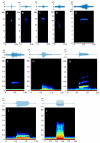Diversity of Underwater Vocalizations in Chinese Soft-Shelled Turtle (Pelodiscus sinensis)
- PMID: 36899669
- PMCID: PMC10000088
- DOI: 10.3390/ani13050812
Diversity of Underwater Vocalizations in Chinese Soft-Shelled Turtle (Pelodiscus sinensis)
Abstract
Sound communication is important for underwater species. The wild population of the Chinese soft-shelled turtle (Pelodiscus sinensis) is listed as vulnerable. However, its vocalization, which can serve as the basis for ecological and evolutionary research, has not been studied. Here, we performed underwater recordings of 23 Chinese soft-shelled turtles of different ages and sexes and identified 720 underwater calls. The turtle calls were manually divided into 10 call types according to visual and aural inspection properties. The similarity test indicated that the manual division was reliable. We described the acoustic properties of the calls and the statistical analysis showed that the peak frequency of calls was significantly different between adult females and males, and also between subadults and adults. Similar to other aquatic turtles that prefer to live in deep water, Chinese soft-shelled turtles have a high vocal diversity and many harmonic calls, indicating that this highly aquatic species developed a variety of vocalizations to enhance their underwater communication, which helped them adapt to the complex and dim underwater environment. Furthermore, the turtles showed a tendency for vocalization to become more diverse with age.
Keywords: Pelodiscus sinensis; age-sex difference; call types; underwater recordings; vocalization diversity.
Conflict of interest statement
All authors declare no conflicts of interest.
Figures



Similar articles
-
Chinese striped-neck turtles vocalize underwater and show differences in peak frequency among different age and sex groups.PeerJ. 2023 Jan 13;11:e14628. doi: 10.7717/peerj.14628. eCollection 2023. PeerJ. 2023. PMID: 36655045 Free PMC article.
-
MicroRNAs May Play an Important Role in Sexual Reversal Process of Chinese Soft-Shelled Turtle, Pelodiscus sinensis.Genes (Basel). 2021 Oct 25;12(11):1696. doi: 10.3390/genes12111696. Genes (Basel). 2021. PMID: 34828302 Free PMC article.
-
Gene synteny, evolution and antiviral activity of type I IFNs in a reptile species, the Chinese soft-shelled turtle Pelodiscus sinensis.Dev Comp Immunol. 2022 Sep;134:104461. doi: 10.1016/j.dci.2022.104461. Epub 2022 Jun 3. Dev Comp Immunol. 2022. PMID: 35660570
-
Effects of dietary sodium butyrate on growth performance, immune function, and intestinal microflora of Chinese soft-shelled turtle (Pelodiscus sinensis).Front Cell Infect Microbiol. 2023 Oct 11;13:1271912. doi: 10.3389/fcimb.2023.1271912. eCollection 2023. Front Cell Infect Microbiol. 2023. PMID: 37886667 Free PMC article.
-
Identification and Expression Analysis of Wnt2 Gene in the Sex Differentiation of the Chinese Soft-Shelled Turtle (Pelodiscus sinensis).Life (Basel). 2023 Jan 9;13(1):188. doi: 10.3390/life13010188. Life (Basel). 2023. PMID: 36676139 Free PMC article.
Cited by
-
Hidden social complexity behind vocal and acoustic communication in non-avian reptiles.Philos Trans R Soc Lond B Biol Sci. 2024 Jul 8;379(1905):20230200. doi: 10.1098/rstb.2023.0200. Epub 2024 May 20. Philos Trans R Soc Lond B Biol Sci. 2024. PMID: 38768204 Free PMC article. Review.
-
Synergistic Efficacy of Doxycycline and Florfenicol Against Aeromonas hydrophilia and Morganella morganii Infections in Pelodiscus sinensis with Skin Ulcer Disease.Vet Sci. 2025 Jun 23;12(7):611. doi: 10.3390/vetsci12070611. Vet Sci. 2025. PMID: 40711271 Free PMC article.
-
Peripheral hearing sensitivity is similar between the sexes in a benthic turtle species despite the larger body size of males.Ecol Evol. 2024 Aug 8;14(8):e70130. doi: 10.1002/ece3.70130. eCollection 2024 Aug. Ecol Evol. 2024. PMID: 39130099 Free PMC article.
-
A Multidrug-Resistant Escherichia coli Caused the Death of the Chinese Soft-Shelled Turtle (Pelodiscus sinensis).Vet Sci. 2025 May 14;12(5):473. doi: 10.3390/vetsci12050473. Vet Sci. 2025. PMID: 40431566 Free PMC article.
References
-
- Shang Y.C. Animal Behavior. 2nd ed. Peking University Press; Beijing, China: 2014. pp. 256–267.
-
- Sacchi R., Galeotti P., Fasola M., Ballasina D. Vocalizations and courtship intensity correlate with mounting success in marginated tortoises Testudo marginata. Behav. Ecol. Sociobiol. 2003;55:95–102. doi: 10.1007/s00265-003-0685-1. - DOI
-
- Galeotti P., Sacchi R., Fasola M., Ballasina D. Do mounting vocalisations in tortoises have a communication function? A comparative analysis. Br. J. Herpetol. 2005;15:61–71.
-
- Ferrara C.R., Mortimer J.A., Vogt R.C. First evidence that hatchlings of Chelonia mydas emit sounds. Copeia. 2014;2:245–247. doi: 10.1643/CE-13-087. - DOI
-
- Galeotti P., Sacchi R., Rosa D.P., Fasola M. Female preference for fast-rate, high-pitched calls in Hermann’s tortoises (Testudo hermanni) Behav. Ecol. 2005;16:301–308. doi: 10.1093/beheco/arh165. - DOI
Grants and funding
LinkOut - more resources
Full Text Sources
Miscellaneous

